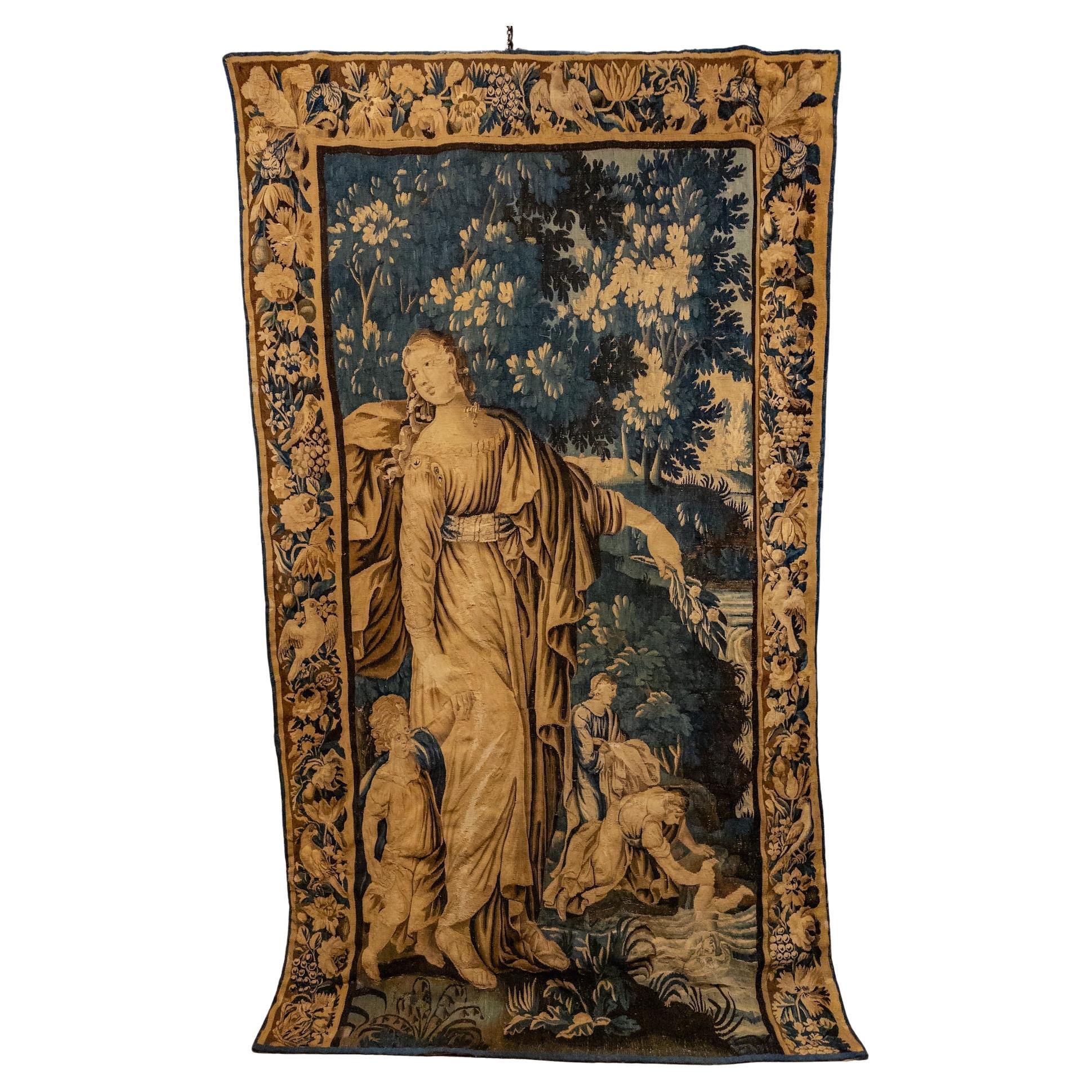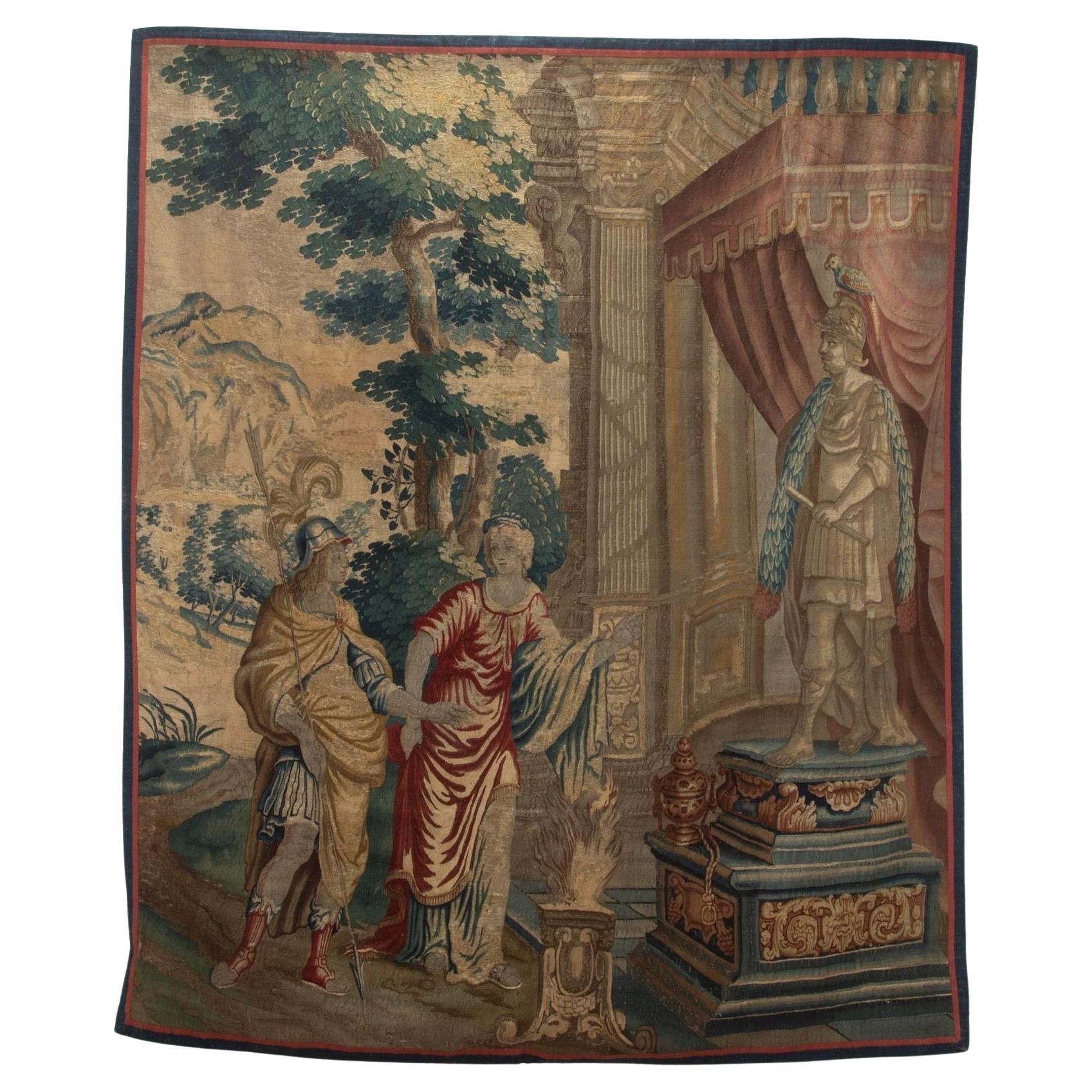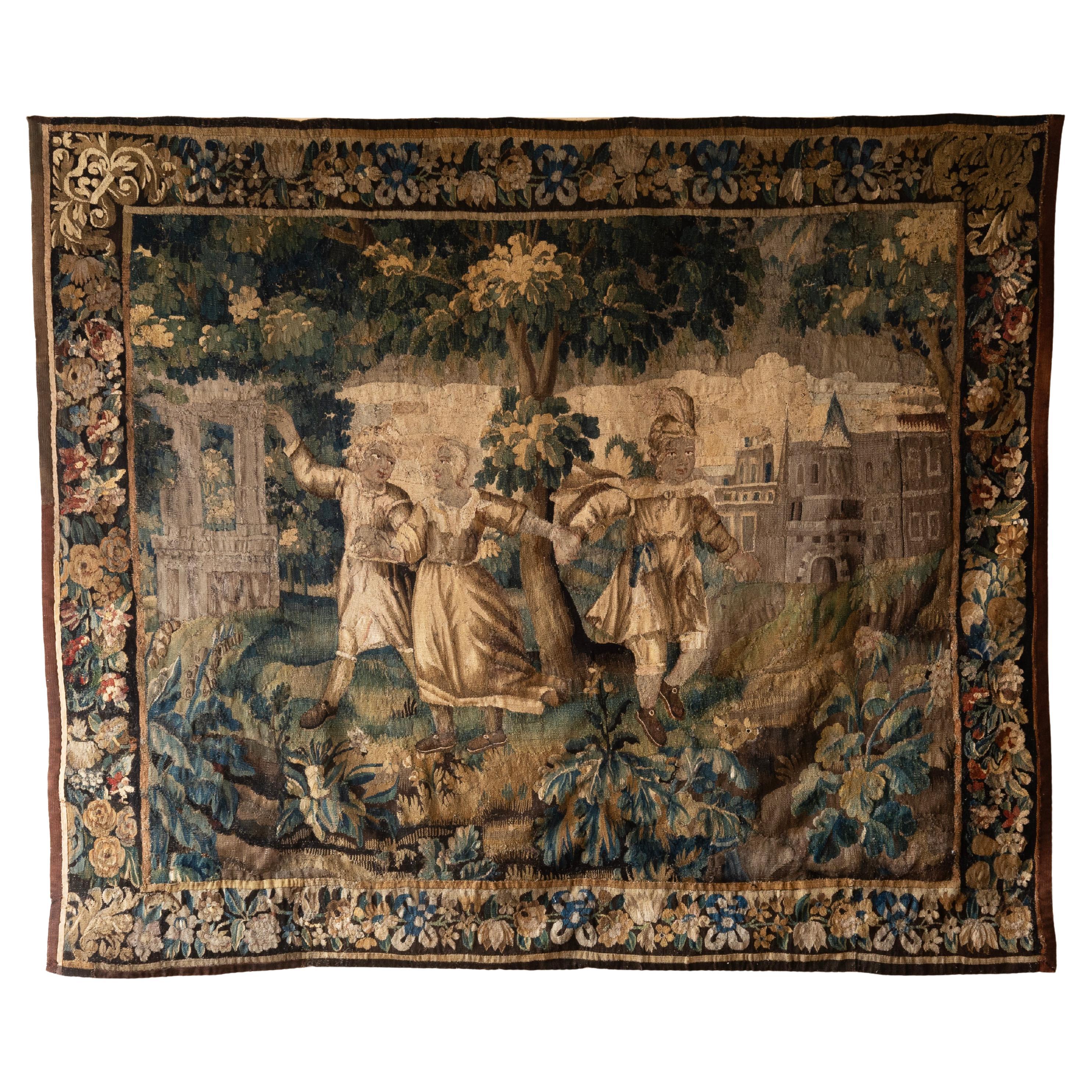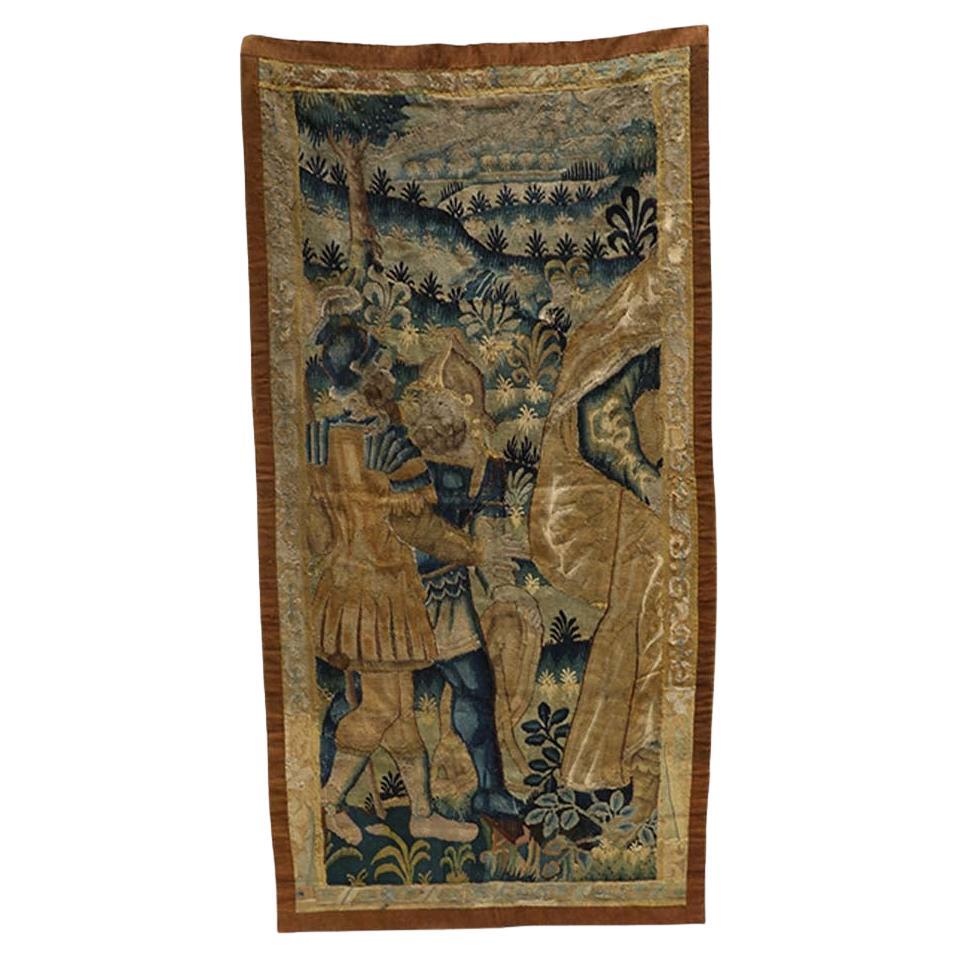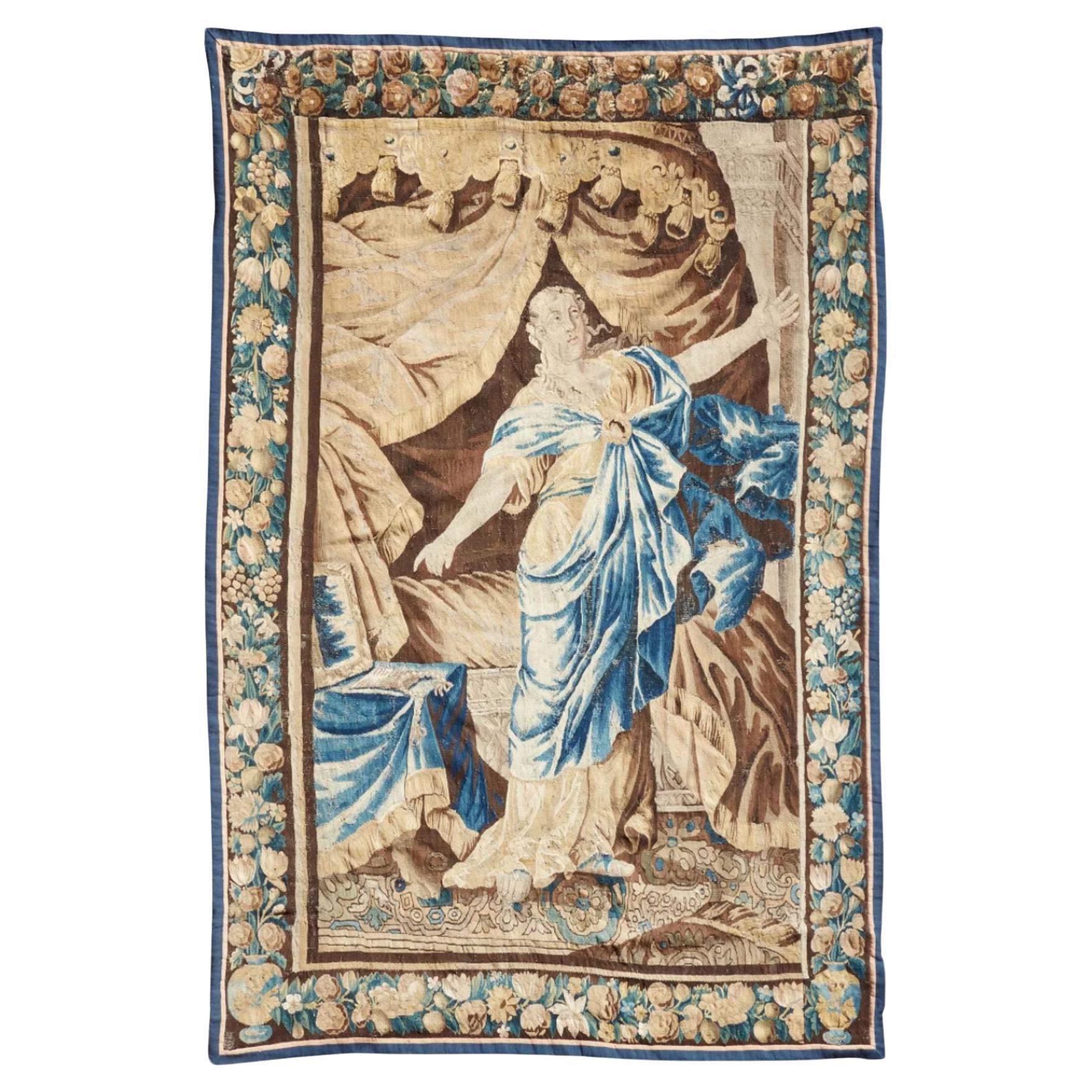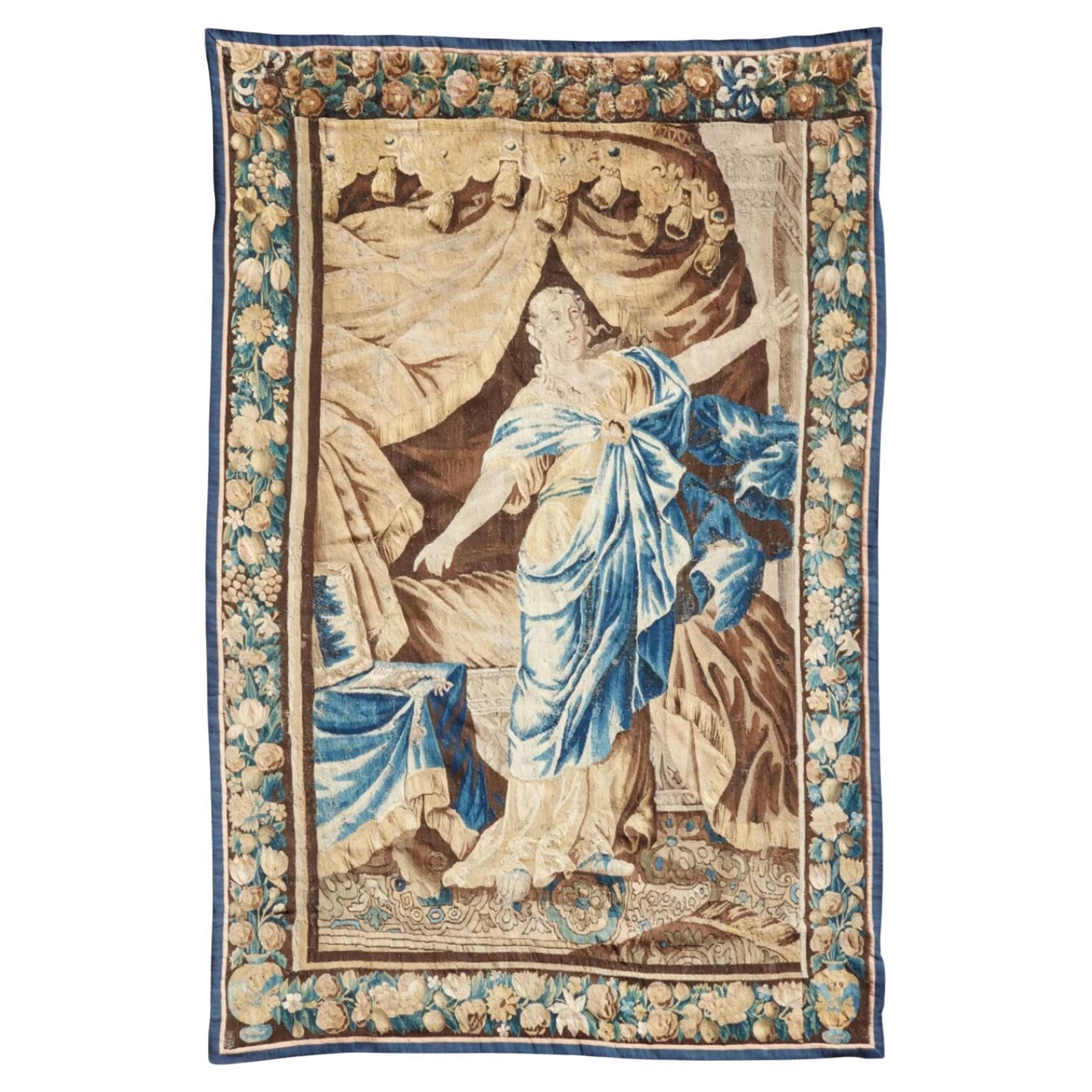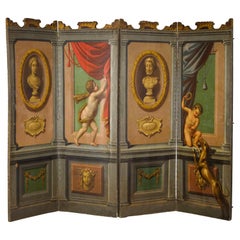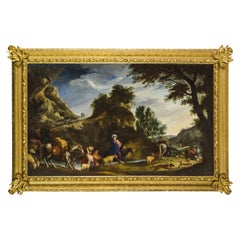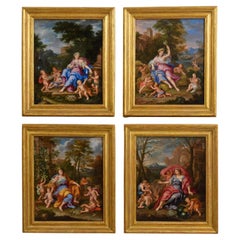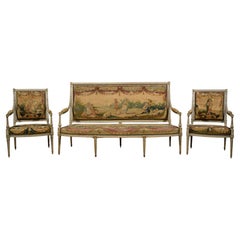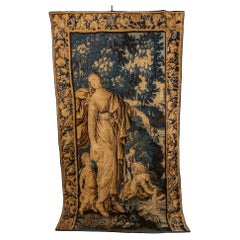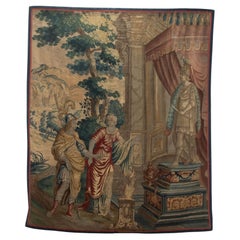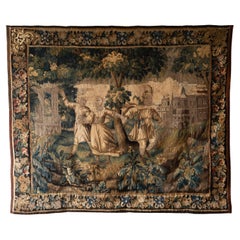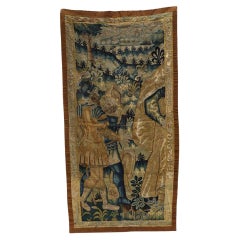Items Similar to 16th Century, Flemish Storied Wood Tapestry
Want more images or videos?
Request additional images or videos from the seller
1 of 6
16th Century, Flemish Storied Wood Tapestry
$37,939.06
£28,393.29
€32,000
CA$52,340.24
A$58,204.52
CHF 30,570.27
MX$711,608.62
NOK 380,934.90
SEK 359,118.72
DKK 243,599.89
About the Item
16th century, Flemish storied wood tapestry
Flanders Brussels
The beautiful and precious tapestry, of fine workmanship and made with wool yarns, was made in the 16th century in Flanders. It presents stylistically close to the works produced by the Brussels manufactory in which you can find comparable chromatic balances and borders with flowers and fruit. Inside a rich border with flowers and fruit, interspersed with cupids and eagles, there is described a scene from ancient mythology.
The tapestry, a form of textile art, has a very long tradition and in Flanders knows the peak of its evolution and its artistic quality between the 13th and 15th century. Flemish tapestries are prestigious works of art, masterpieces of elegance, commissioned by noble clients for their palaces. Since the beginning of the 15th century the most important centre of production is Arras (from which the Italian name derives: tapestry). Already in the second half of the 15th century there were other important factories in Bruges, Oudenaarde, Antwerp and Brussels.
From the second half of the 15th century and up to the 17th century. Brussels was the capital of European tapestry.
The success of the decorative tapestry is partly explained by its easy portability: kings and nobles could roll them up and carry them from one residence to another and were draped on the walls of castles for insulation during the winter, as well as for decorative display.
The iconography of most tapestries dates back to written sources such as the Bible and Ovid’s Metamorphosis; religious and mythological images are therefore the subject of many tapestries produced in this period.
- Dimensions:Height: 122.05 in (310 cm)Width: 159.45 in (405 cm)Depth: 0.79 in (2 cm)
- Style:Renaissance (Of the Period)
- Materials and Techniques:Wool,Hand-Woven
- Place of Origin:
- Period:
- Date of Manufacture:16th Century
- Condition:
- Seller Location:IT
- Reference Number:1stDibs: LU4405218832662
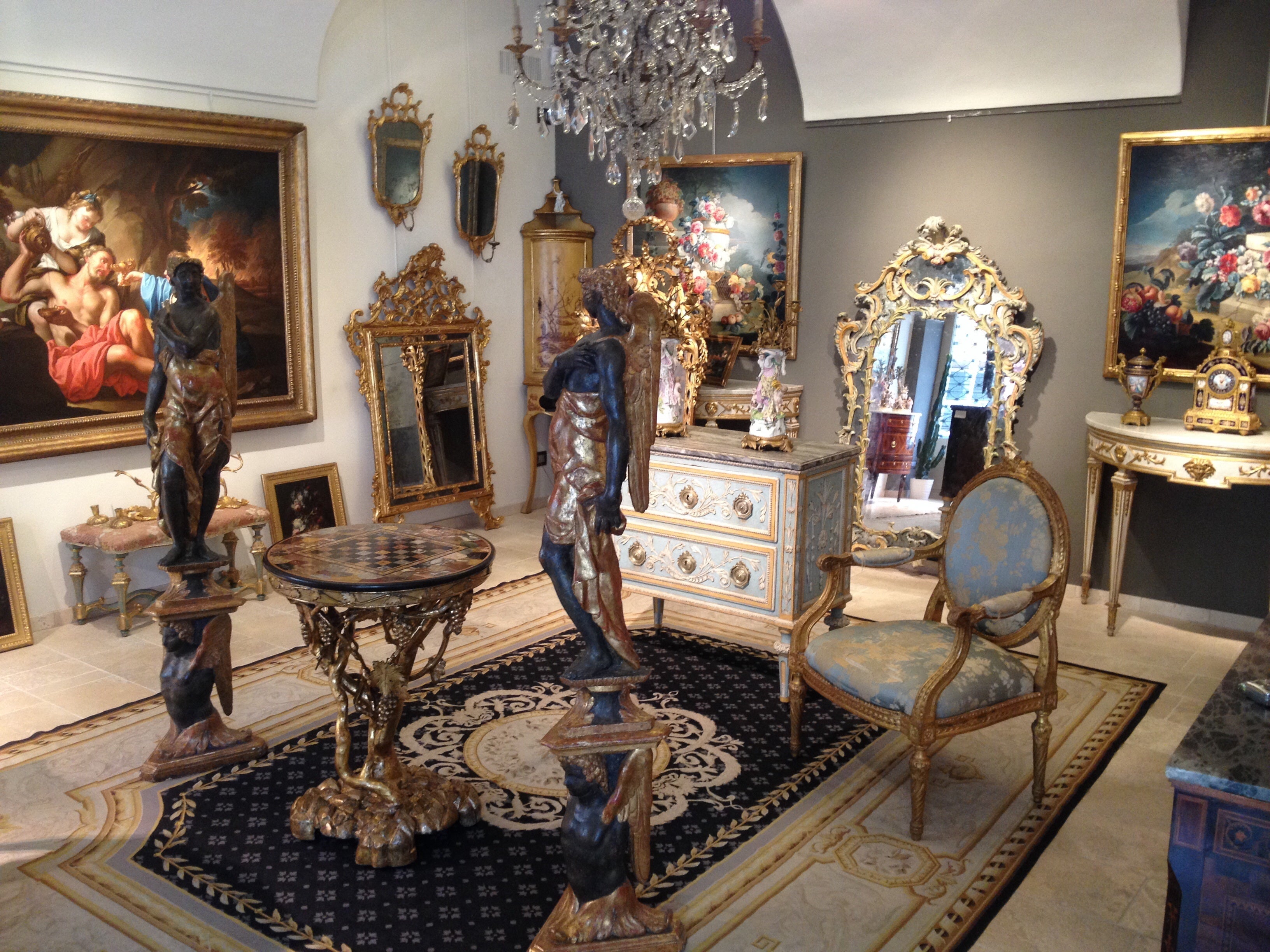
About the Seller
5.0
Platinum Seller
Premium sellers with a 4.7+ rating and 24-hour response times
Established in 1980
1stDibs seller since 2019
56 sales on 1stDibs
Typical response time: <1 hour
- ShippingRetrieving quote...Shipping from: Italy
- Return Policy
Authenticity Guarantee
In the unlikely event there’s an issue with an item’s authenticity, contact us within 1 year for a full refund. DetailsMoney-Back Guarantee
If your item is not as described, is damaged in transit, or does not arrive, contact us within 7 days for a full refund. Details24-Hour Cancellation
You have a 24-hour grace period in which to reconsider your purchase, with no questions asked.Vetted Professional Sellers
Our world-class sellers must adhere to strict standards for service and quality, maintaining the integrity of our listings.Price-Match Guarantee
If you find that a seller listed the same item for a lower price elsewhere, we’ll match it.Trusted Global Delivery
Our best-in-class carrier network provides specialized shipping options worldwide, including custom delivery.More From This Seller
View All18th Century Italian Neoclassical Oil on Canvas Screen with Trompe L’œil
Located in IT
18th century, large Italian neoclassical oil on canvas four panels screen with Trompe L’œil
These large screen is composed of four panels in oil on canvas painted. Neoclassical, dating to the second half of the 18th century.
Each panel represents a trompe l'oeil, with a classical architecture with square section marble columns and large clogging. Inside the pink space of the first and third panels are painted, as inserted in a niche with bronze frame, ancient busts...
Category
Antique Late 18th Century Italian Neoclassical Paintings
Materials
Canvas
17th Century, Italian Painting by Pier Francesco Cittadini, Jacob and his Family
Located in IT
Pier Francesco Cittadini (Milan, 1616-Bologna, 1681)
"Jacob and his family go to Egypt"
Oil on canvas, cm 109 x 190 (canvas only)
The valuable painting, made in oil on canvas, depicts Jacob and his family go to Egypt and we believe it can be, given the high quality painting, autograph work of Italian Pier Francesco Cittadini (Italy Milan, 1616 - Bologna, 1681) made after 1647. The work, in excellent condition is accompanied by a coeval frame in wood finely carved and golden.
The scene depicted, which was confused with the Flight to Egypt in the past years, is instead identified with the biblical episode of Jacob’s journey. In the foreground, reading the painting from left to right, we see a caravan composed of animals, including donkeys, dromedaries, goats, dogs and horses and people, women, men and slaves, who carry on their journey along the banks of a river, following a path that to the right, would seem to lead to the through of a bridge. In addition to the watercourse is described an environment characterized by large rocks and impervious come far to cover the entire verticality of the canvas. On the left, in the distance, we see the tail of the caravan that runs along the steep path. Large trees enliven and harmonize the environment, as well as white and grey clouds characterize the predominantly clear sky and illuminated on the right by sunlight.
The story is told in the Bible, Book of Genesis, 30, 25, passage in which is described the flight of Jacob from Haran after the contrasts with Laban, father of his wife Rachel. Jacob is the third great patriarch of the Bible. From his descendants originate the twelve generations of the people of Israel. He is the son of Isaac and Rebekah, who led him to flee from the wrath of Esau to Haran to seek refuge from his brother, Laban. At his uncle’s house Jacob met his daughter Rachel. As soon as he saw his cousin, Jacob was taken. Jacob will stay seven years in the service of Laban to marry his beloved Rachel. But Laban, with a deception, will give him in marriage first Lia, the least beautiful eldest daughter, and only after another seven years the splendid Rachel. From his first wife he will have several children, while Rachel will give birth to the beloved son, Joseph, who will become viceroy of Egypt.
After years of service, Jacob asked to be paid with every dark-coloured garment among the sheep and every spotted and dotted garment among the goats. Laban accepted and sent away from his sons all the leaders of that kind. So Jacob took fresh branches of poplar, almond and plane tree, and flayed them, and put them in the troughs. The optical suggestion induced the goats and the sheep to conceive and give birth to dark, striped and dotted garments. He also ensured that all the strongest and healthiest leaders of the flock of Laban would drink near the barked branches, thus assuring a genetic superiority to his part of the flock. His flocks grew numerous and strong and he became richer than his relative, arousing envy. It was clear that Laban would not respect him much longer. At the suggestion of the Lord, Jacob decided to return to Canaan. Trying to avoid any possible dispute, he left with his family while Laban was absent for shearing sheep. But when, three days later, his uncle returned home, he became angry, feeling offended because Jacob had gone secretly and had not allowed him to greet his daughters and grandchildren. In addition, his teraphim, statuettes, or idols, which depicted the family deities, had disappeared. After 7 days of pursuit, Laban and his men reached Jacob’s group on Mount Gilead, in the mountainous region west of the Euphrates River, where his uncle and grandson had a stormy conversation. The younger man was outraged at being accused of stealing idols and told Labano to rummage through his family’s tents at will. Neither of them could know or even imagine that it was Rachel who took the idols and hid them in the saddle of the camel. During the search, she sat down firmly on the saddle, apologizing for not being able to get up, «because I usually have what happens to women» (Gen 31:35). So the loot wasn’t discovered.
The author of this work was inspired by the composition of an engraving by Stefano Della Bella (1610-1664) of circa 1647. The engraving by Stefano della Bella bears the title "Iacob sur ses vieux jours quitte sans fascherie pour voir son filz Ioseph, sa terre et sa patrie" and is signed on the bottom left "Stef. of the Beautiful In. et fe." while on the right it is declared "Cum privil. Regis", that is with license of the king.
Stefano Della Bella (Italy - Florence, May 18, 1610-Florence, July 12, 1664) was born in a family of painters, sculptors and goldsmiths and was left early orphan of his father sculptor, he dedicated himself first to the art of goldsmith at the school of Giovanni Benedetto Castiglione and Gasparo Mola, then turning his attention to drawing and engraving. He soon began drawing figures and copying the etchings of Jacques Callot, which inspired his early works. Under the protection of the Medici, in particular of Don Lorenzo, cadet son of Grand Duke Ferdinand I, Della Bella has the opportunity to make study trips to Rome, where he stayed from 1633-1636; In Rome he met French engravers and publishers of prints such as Israël Henriet and François Langlois, who influenced his decision to move to Paris in 1639, four years after the death of Callot. In Paris he soon reached, thanks to the engravings commissioned by Cardinal Richelieu, the success also worldly; he frequented courtiers, theatre artists and writers, while refusing too oppressive honors. In 1646-1647 he continued his travels in the Netherlands to Amsterdam, Antwerp and Dordrecht. He returned to Florence in 1650 and resumed working under the protection of the Medici court, working for his patrons. In 1656 he became a member of the Academy of Apatists.
The painting object of this study is reasonably attributable to Pier Francesco Cittadini, or Pierfrancesco Cittadini, called the Milanese or the Franceschino (Italy - Milan, 1616-Bologna, 1681) as some exemplary stylistic comparisons proposed to follow can prove.
Pier Francesco Cittadini was an Italian baroque painter, mainly active in Bologna.
His artistic training first took place with the painter Daniele Crespi...
Category
Antique Mid-17th Century European Baroque Paintings
Materials
Canvas, Giltwood
17th century, Four French Paintings Depicting The Seasons, Circle of Noel Coypel
By Noël Coypel
Located in IT
Four paintings depicting the seasons, circle of Noel Coypel, second half of the 17th century
Oil on canvas
Measures: cm W 37 x H 46 x D 2 cm (canvas)
The four paintings, presented in...
Category
Antique Late 17th Century French Baroque Paintings
Materials
Canvas
18th Century, French Louis XVI Lacquered Wood Seat Furniture, Aubusson Tapestry
Located in IT
18th Century, A French Louis XVI Lacquered Wood Seat Furniture with Aubusson Tapestry
Dimensions:
Sofa: cm W 180 x D 75 x H 109. Seat H 43 cm
Armchairs: cm W 64 x D 64 x H 96. Seat H...
Category
Antique Late 18th Century French Louis XVI Living Room Sets
Materials
Tapestry, Wood
18th Century, Painting Architectural Capriccio, att. to Isaac De Moucheron
Located in IT
18th Century, Painting with Architectural Capriccio with figures, attributed to Isaac De Moucheron
Measures: canvas cm H 108 x L 152; with frame cm H 132 x L 176 x 8
The painting i...
Category
Antique 18th Century Dutch Baroque Paintings
Materials
Canvas
18th Century, Baroque Austran Painting by August Querfurt
Located in IT
August Querfurt (1696, Wolfenbüttel - 1761, Vienna)
Farmers and villagers at the entrance of a village
Oil on panel , cm 38,5 x 51. frame 66 x 53,5 x 4,5 cm
The valuable painting, ...
Category
Antique 18th Century Austrian Baroque Paintings
Materials
Wood
You May Also Like
17th Century Flemish Aubusson Tapestry
Located in Houston, TX
The 17th Century Flemish Aubusson Tapestry portraying a woman traveling or walking with her child is a captivating depiction of everyday life...
Category
Antique 17th Century Belgian Baroque Tapestries
Materials
Wool, Silk
17th Century Flemish Mythological Tapestry
Located in Gloucestershire, GB
Beautiful and well preserved 17th Century Flemish mythological tapestry, possibly Wauters Workshop, Flanders, Antwerp. Retaining good colour and backed in Belgium linen. With some be...
Category
Antique 17th Century Belgian Baroque Tapestries
Materials
Tapestry
17th Century French Baroque Tapestry
Located in Allerum, SE
17th century French Baroque wool and silk tapestry. Work of Felletin, ca 1690 France.
Category
Antique 17th Century French Baroque Tapestries
Materials
Wool, Silk
17th Century Flemish Tapestry
Located in Los Angeles, CA
17th century Flemish Tapestry
Dimensions: 45"w x 85.5"h
Origin: Belgium
Material: Wool and silk
17th century
VNT1707
Category
Antique 17th Century Belgian Neoclassical Tapestries
Materials
Wool, Silk
17th Century Flemish Baroque Tapestry
Located in New Orleans, LA
This larger than life tapestry is simply breathtaking. The baroque scene is depicted in woven hues of vibrant blue and soft neutrals. Standing at the grand height of eight feet eleve...
Category
Antique 17th Century Belgian Baroque Tapestries
Materials
Fabric
17th Century Flemish Baroque Tapestry
Located in New Orleans, LA
A 17th Century Flemish Baroque tapestry with
Dramatic composition and movement –The central figure is in a dynamic pose with flowing draperies, and strong diagonals to convey action...
Category
Antique 17th Century Belgian Baroque Tapestries
Materials
Wool
More Ways To Browse
Hand Made Tapestry
Italian Renaissance 15th Century
Bible 16th Century
17th Century Italian Tapestry
Eagle Tapestry
Cupid Tapestry
Ancient Bible
Arras Tapestry
Oudenaarde Tapestry
Hunt Tapestry
Tapestry With Cherubs
4 X 5 Tapestries
Antique Embroidered Picture
Flemish Blue Tapestry
Macrame Hanging
14th Century Tapestry
Medieval Angel
Mille Fleur
